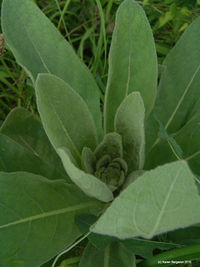Verbascum thapsus
| See Also | Botanical Monographs |
|---|
Traditionally Mullein (Verbascum thapsus) was used as a tea for the treatment of coughs. The soothing action of mullein coats sore throats and makes coughing more productive. It has many actions with respect to inflammation in the head, neck and upper chest. To explore the characteristics, medicinal uses and prescribing considerations of this herb in more detail, check out the references indicated.[1], [2]
Contents
Characteristics
- Common Names: Mullein
- Family: Scrophulariaceae
- Habitat: Verbascum sinuatum can be found in Europe, Asia, and North Africa
- Parts Used: Leaf, flower
- Constituents: bioflavonoids, essential oils, saponins, mucilage (in the leaf), resin
- Medicinal Actions: demulcent, emollient, antitussive, decongestant, expectorant, genitourinary sedative, anodyne, diuretic (weak action), pectoral, vulnerary
Uses
Historical Uses:
Verbascum sinuatum was used historically by Native North Americans for the treatment of tuberculosis. It was also traditionally used as a tea and was combined with other herbs for treating coughs.
Medicinal Uses:
Internal
- bronchial irritation, nervous bronchial irritation with dry hoarse cough, hoarseness worse when lying down; from inhalants, leaves are smoked as a substitute for tobacco for sore throats and asthma
- irritation of genitourinary and gastrointestinal tracts, spasm or chronic cystitis that produces urinary irritation (dribbling, catarrh, sometimes with painful urination), cancer of the genitourinary system
External
- pain relief for otitis, rheumatic joints, inflamed piles, ulcers, tumours
- leaves are crushed, macerated, soaked in water and made into a fomentation
- Other Conditions
- tonsillitis, malignant sore throat, and mumps (poultice)
Flowers (steeped in olive oil)
- Other Conditions
Prescribing Considerations
The information provided is intended to augment the treatment from a naturopathic doctor or other trained medical professional. Although most herbs are generally safe, it is recommended that you avoid self-prescribing especially when there is an underlying ongoing medical condition, if you are on any prescription medications or if you are pregnant or breastfeeding.
Formulations and Preparation
- Tincture - 10-60 drops three times daily
- Fluid extract - 5-25 drops three times daily (40% alcohol)
Safety
The safety and prescribing considerations for this herb include:[3], [4]
- Generally regarded as safe.
- Side-effects are generally not seen.
- Drug-Herb Interactions are rare.
References
- ↑ Boon Heather, Smith Michael (2009) 55 Most Common Medicinal Herbs: The Complete Natural Medicine Guide Second Edition Institute of Naturopathic Education and Research, CCNM Toronto.
- ↑ Godfrey Anthony, Saunders Paul, Barlow Kerry, Gowan Matt (2011) Principles and Practices of Naturopathic Botanical Medicine, Advanced Botanical Medicine. V3 CCNM Press, Toronto.
- ↑ Stargrove Mitchell Bebell, Treasure Jonathan, McKee Dwight L (2008) Herb, Nutrient and Drug Interactions: Clinical Implications and Therapeutic Strategies
- ↑ Brinker Francis (1997) Herbal Contraindications and Drug Interactions: Plus Herbal Adjuncts With Medicines, 4th Edition Eclectic Medical Publications.
